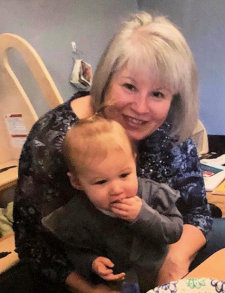

I was working 10-12 hour days in a fairly demanding job and was tired all of the time. I was working out and losing weight but gaining girth. Then I had some spotting, which was a little concerning as I had been in menopause for over a year. I mentioned it to a friend, who encouraged me to consult my gynecologist. That advice saved my life. My gynecologist performed a pelvic exam, followed by a transvaginal ultrasound, and identified a large growth. My doctor made a phone call and secured an appointment with an experienced gynecological oncologist for that afternoon. Our fears were confirmed; all signs pointed to ovarian cancer. Following a flurry of tests, debulking surgery was scheduled for April 2013.
Like most of us, my husband and I had no idea of what to expect. We were fortunate we had found an excellent medical team, and we had a strong support system around us. Except for the fact that I was found to have a softball size tumor on each of my ovaries and was staged with 3C ovarian cancer, the actually surgery was unremarkable. The decision was made for me to undergo both IP (intraperitoneal) and IV chemotherapy, and ports were placed. Chemotherapy was initiated three weeks after completion of my debulking surgery.
Chemotherapy consisted of carboplatin, cisplatin, and taxol. We had some deviations to standard drugs due to issues with my IP port. In total, I was able to have four IP cisplatin treatments. Treatment was hard for me. We struggled to stay on top of magnesium and potassium loss caused by chemo-inducted kidney damage. I had fluids and additional magnesium infusions a minimum of twice a week throughout most of my treatment and for several months following treatment. I had several blood transfusions. But it was all worth it as I completed treatment with low CA-125 numbers and no evidence of disease.
My CA-125 remained low – roughly 6.5 – until February 2017. At that time my level showed a slight increase—not enough to panic but enough for me to be concerned. By May, my CA-125 had tripled. My doctor ordered an abdominal CT scan, which came back clear. We waited three more months and retested my CA-125 level. It had increased to the mid-30’s. This is low for an average woman, but for me it indicated a return of cancer. I underwent a second CT-scan, this time including my chest to evaluate potential lymph node involvement. The CT scan was clear with the exception of a small nodule in my right lung. I underwent a PET scan, and the nodule lit up indicating a probability of cancer. We met with our doctor to discuss our next steps. I had no symptoms, and things were not presenting in a manner that was typical for ovarian cancer. If this were ovarian cancer, we would wait and watch. But if by any chance it weren’t ovarian cancer, we would want the option for early treatment. I had smoked very minimally 30 years prior but had grown up with parents who were both heavy smokers. We decided to pursue a needle biopsy of the nodule. The biopsy results indicated the nodule was non-small cell lung cancer. I underwent a surgery in October for the removal of the upper lobe of my right lung. My lung cancer was found to be stage 1b. After consultation with two medical oncologists, it has been determined that no additional treatment is required. I will undergo CT scans every six months for two years, and then annually for three additional years.
I have not had my CA-125 tested since August 2018. I am symptom free, and as the CA-125 is sensitive to inflammation, my doctor suggested pausing our ovarian cancer monitoring until 4-6 months after my lung cancer surgery. I have recently scheduled my appointments, and will work to establish a new CA-125 baseline. I am so grateful I appear to be very sensitive to this biomarker, as it helped identify a second primary cancer, potentially saving my life.
Throughout this process, we have come to believe that the biggest choice we have in this process is that of selecting our medical team. We have been fortunate to find doctors who are experienced, knowledgeable, and communicative. They have allowed us to be actively involved in my care decisions, listening to our concerns and addressing our questions fully and completely.
